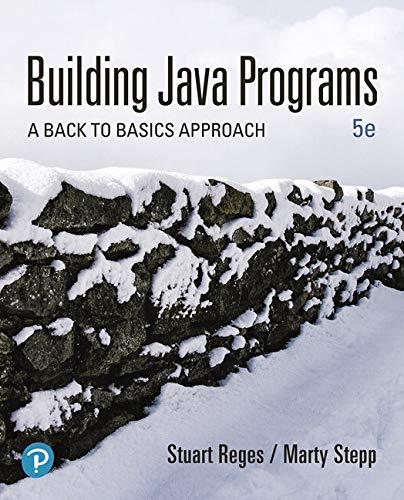
Building Java Programs: A Back To Basics Approach (5th Edition)
5th Edition
ISBN: 9780135471944
Author: Stuart Reges, Marty Stepp
Publisher: PEARSON
expand_more
expand_more
format_list_bulleted
Concept explainers
Question
Chapter 14.2, Problem 12SCP
Program Plan Intro
Stack:
- Stack works based on the Last-In-First-Out (LIFO) structure.
- There are two method are used,
- “push()”:
- The element is inserted to the top of the stack using this method.
- Whenever the user tries to inserts the element into the stack, the last element which is currently to be inserted will be at the top of the stack.
- “pop()”:
- The element at the top of the stack is popped out using this method.
- This method returns and deletes the element from the top of the stack.
- The element which is inserted last will be removed first from the stack.
- “push()”:
Queue:
- Queue works based on the First-In-First-Out (FIFO) structure.
- The elements are inserted into the queue only at the rear end.
- The elements can be deleted only at the front end.
- Two important methods are used in queue,
- “add()” : To insert the element at the rear end of the queue, this method is used.
- “remove()”: To remove the element at the front end of the queue, this method is used.
Explanation of Solution
Advantages:
- Stack or queues are useful to represent many common operations.
- If the user has the index or key, then the lists or maps provide instant access to any of its corresponding elements...
Expert Solution & Answer
Want to see the full answer?
Check out a sample textbook solution
Students have asked these similar questions
I need to define and discuss the uses of one monitoring or troubleshooting tool in Windows Server 2019. thank you
I would likr toget help with the following concepts:
- Windows Server features
- Windows Server versus Windows 10 used as a client-server network
I need to define and discuss the uses of one monitoring or troubleshooting tool in Windows Server 2019. thank you
Chapter 14 Solutions
Building Java Programs: A Back To Basics Approach (5th Edition)
Ch. 14.1 - Prob. 1SCPCh. 14.1 - Prob. 2SCPCh. 14.1 - Prob. 3SCPCh. 14.1 - Prob. 4SCPCh. 14.1 - Prob. 5SCPCh. 14.1 - Prob. 6SCPCh. 14.1 - Prob. 7SCPCh. 14.1 - Prob. 8SCPCh. 14.1 - Prob. 9SCPCh. 14.1 - Prob. 10SCP
Ch. 14.2 - Prob. 11SCPCh. 14.2 - Prob. 12SCPCh. 14.2 - Prob. 13SCPCh. 14.2 - Prob. 14SCPCh. 14.2 - Prob. 15SCPCh. 14.2 - Prob. 16SCPCh. 14.3 - Prob. 17SCPCh. 14.3 - Prob. 18SCPCh. 14.3 - Prob. 19SCPCh. 14.3 - Prob. 20SCPCh. 14.3 - Prob. 21SCPCh. 14.3 - Prob. 22SCPCh. 14.3 - Prob. 23SCPCh. 14 - Prob. 1ECh. 14 - Prob. 2ECh. 14 - Prob. 3ECh. 14 - Prob. 4ECh. 14 - Prob. 5ECh. 14 - Prob. 6ECh. 14 - Prob. 7ECh. 14 - Prob. 8ECh. 14 - Prob. 9ECh. 14 - Prob. 10ECh. 14 - Prob. 11ECh. 14 - Prob. 12ECh. 14 - Prob. 13ECh. 14 - Prob. 14ECh. 14 - Prob. 15ECh. 14 - Prob. 16ECh. 14 - Prob. 17ECh. 14 - Prob. 18ECh. 14 - Prob. 19ECh. 14 - Prob. 20ECh. 14 - Prob. 21ECh. 14 - Prob. 1PPCh. 14 - Prob. 3PP
Knowledge Booster
Learn more about
Need a deep-dive on the concept behind this application? Look no further. Learn more about this topic, computer-science and related others by exploring similar questions and additional content below.Similar questions
- Please solve and answer the questions correctly please. Thank you!!arrow_forwardConsidering the TM example of binary sum ( see attached)do the step-by-step of execution for the binary numbers 1101 and 11. Feel free to use the Formal Language Editor Tool to execute it; Write it down the current state of the tape (including the head position) and indicate the current state of the TM at each step.arrow_forwardI need help on inculding additonal code where I can can do the opposite code of MatLab, where the function of t that I enter becomes the result of F(t), in other words, turning the time-domain f(t) into the frequency-domain function F(s):arrow_forward
arrow_back_ios
SEE MORE QUESTIONS
arrow_forward_ios
Recommended textbooks for you
 Database System ConceptsComputer ScienceISBN:9780078022159Author:Abraham Silberschatz Professor, Henry F. Korth, S. SudarshanPublisher:McGraw-Hill Education
Database System ConceptsComputer ScienceISBN:9780078022159Author:Abraham Silberschatz Professor, Henry F. Korth, S. SudarshanPublisher:McGraw-Hill Education Starting Out with Python (4th Edition)Computer ScienceISBN:9780134444321Author:Tony GaddisPublisher:PEARSON
Starting Out with Python (4th Edition)Computer ScienceISBN:9780134444321Author:Tony GaddisPublisher:PEARSON Digital Fundamentals (11th Edition)Computer ScienceISBN:9780132737968Author:Thomas L. FloydPublisher:PEARSON
Digital Fundamentals (11th Edition)Computer ScienceISBN:9780132737968Author:Thomas L. FloydPublisher:PEARSON C How to Program (8th Edition)Computer ScienceISBN:9780133976892Author:Paul J. Deitel, Harvey DeitelPublisher:PEARSON
C How to Program (8th Edition)Computer ScienceISBN:9780133976892Author:Paul J. Deitel, Harvey DeitelPublisher:PEARSON Database Systems: Design, Implementation, & Manag...Computer ScienceISBN:9781337627900Author:Carlos Coronel, Steven MorrisPublisher:Cengage Learning
Database Systems: Design, Implementation, & Manag...Computer ScienceISBN:9781337627900Author:Carlos Coronel, Steven MorrisPublisher:Cengage Learning Programmable Logic ControllersComputer ScienceISBN:9780073373843Author:Frank D. PetruzellaPublisher:McGraw-Hill Education
Programmable Logic ControllersComputer ScienceISBN:9780073373843Author:Frank D. PetruzellaPublisher:McGraw-Hill Education

Database System Concepts
Computer Science
ISBN:9780078022159
Author:Abraham Silberschatz Professor, Henry F. Korth, S. Sudarshan
Publisher:McGraw-Hill Education

Starting Out with Python (4th Edition)
Computer Science
ISBN:9780134444321
Author:Tony Gaddis
Publisher:PEARSON

Digital Fundamentals (11th Edition)
Computer Science
ISBN:9780132737968
Author:Thomas L. Floyd
Publisher:PEARSON

C How to Program (8th Edition)
Computer Science
ISBN:9780133976892
Author:Paul J. Deitel, Harvey Deitel
Publisher:PEARSON

Database Systems: Design, Implementation, & Manag...
Computer Science
ISBN:9781337627900
Author:Carlos Coronel, Steven Morris
Publisher:Cengage Learning

Programmable Logic Controllers
Computer Science
ISBN:9780073373843
Author:Frank D. Petruzella
Publisher:McGraw-Hill Education